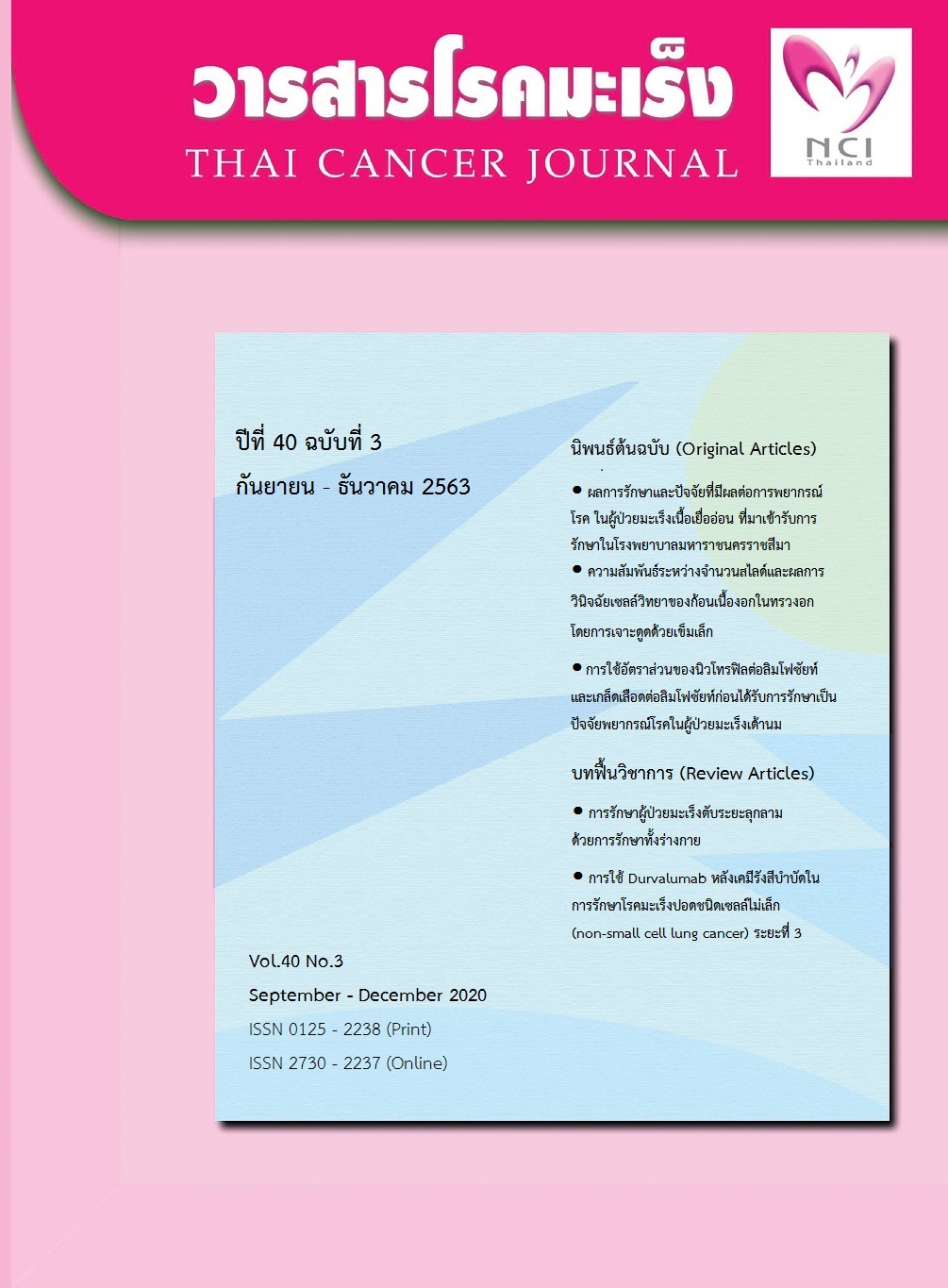Utility of Neutrophil-to-Lymphocyte Ratio and Platelet-to-Lymphocyte Ratio as Prognostic Factors in Pretreatment Breast-cancer Patients
Keywords:
breast cancer, prognosis, neutrophil to lymphocyte ratio, platelet to lymphocyte ratioAbstract
Breast cancer is the most frequently diagnosed and leading cause of cancer deaths among females worldwide. Neutrophils are one of the immune cells involved in the inflammatory process related to the cause of cancer. The aim of the present study was to utilize the neutrophil-to-lymphocyte ratio (NLR) and platelet-to-lymphocyte ratio (PLR) as prognostic factors in breast cancer patients. The medical records of 434 breast cancer patients diagnosed at the National Cancer Institute between 1997 and 2017 were reviewed. The results showed that the mean age of the patients was 50.76 years (SD=10.76). The NLR and PLR were 0.61–15.61 (mean 2.49±1.77) and 3.48–99.18 (mean 11.51±8.12), respectively. The findings from multivariate analysis revealed that high NLR (≥2) and high PLR (≥9.4) were not related to the overall survival of breast-cancer patients. In addition, we found that patients with lymph-node metastasis, negative PR and positive HER-2 had significantly poorer survival rates than the reference group (hazard ratio=6.6, 3.2 and 3.4; P=0.001, 0.007 and 0.023, respectively); no association was found between the other prognostic factors and survival. This study suggests that NLR and PLR were not prognostic factors for breast-cancer patients.
References
and mortality worldwide for 36 cancers in 185 countries. CA : Cancer J Clin 2018;68:394-424.
2. Imsamran W, Pattatang A, Supaattagorn P, Chiawiriyabunya I, Namthaisong K, Wongsena M, et al. Cancer in Thailand:Vol.IX,2013-2015.
Available from: http://www.nci.go.th/th/File_download/Nci%20Cancer%20Registry/In%20Cancer%20in%20Thailand%20IX%20OK.pdf. Accessed October 30, 2020.
3. National Cancer Institute. Hospital based cancer registry 2017. Available from: http://www.nci.go.th/th/File_download/Nci%20Cancer%20Registry/HOSPITALBASED%202016%20Revise%204%20Final.pdf. Accessed October 30, 2020.
4.Templeton AJ, McNamara MG, Šeruga B, Vera-Badillo FE, Aneja P, Ocaña A, et. al. Prognostic role of neutrophil-to-lymphocyte ratio in solid tumors:
A systematic review and meta-analysis. J Natl Cancer Inst 2014;106. Available from: https://doi.org/10. 1093/jnci/dju124. Accessed Setember 30, 2020.
5.สาลักษณ์ แท่นแก้ว, โสพิศ วงศ์คำ. การประยุกต์ใช้ค่าอัตราส่วนของนิวโตรฟิลต่อลิมโฟไซต์ในเลือดเพื่อการพยากรณ์โรค. ศรีนครินทร์เวชสาร 2559;31:332-8.
6.Lorente D, Mateo J, Templeton A J, Zafeiriou Z, Bianchini D, Ferraldeschi R, Bahl A, et al. Baseline neutrophil-lymphocyte ratio (NLR) is associated
with survival and response to treatment with second-line chemotherapy for advanced prostate cancer independent of baseline steroid use. Ann Oncol 2015;26:750-5.
7. DeNardo DG, Coussens LM. Inflammation and breast cancer. Balancing immune response: crosstalk between adaptive and innate im-mune cells
during breast cancer progression. Breast Cancer Res 2007;9:212. Available from https://breast-cancer-research.com/content/9/4/212. Accessed November 2, 2020
8. มาลินี ธานี, พวงรัตน์ ยงวณิชย์, วัชรินทร์ ลอยลม. องค์ประกอบและบทบาทของสภาวะแวดล้อมของเซลล์มะเร็ง. ศรีนครินทร์เวชสาร 2555;27:424-32.
9. Zahorec R. Ratio of neutrophil to lymphocyte counts rapid and simple parameter of systemic inflammation and stress in critically ill. Bratisl Lek Listy 2001;102:5-14.
10. Areerattanavet K, Kaewkangsadan V, Asanprakit W, Satthaporn S, Vassanasiri W. Evaluation of pre-treatment neutrophil to lymphocyte ratio (NLR) in prediction of
disease free survival (DFS) in patients with operable breast cancers. RTA Med J 2017;70:119-26.
11. Li MX, Liu XM, Zhang XF, Zhang JF, Wang WL, Zhu Y, et al. Prognostic role of neutrophil-to- lymphocyte ratio in colorectal cancer: a systematic
review and meta-analysis. Int J Cancer 2014;134:2403-13.
12. Dimitriou N, Felekouras E, Karavokyros I, Alexandrou A, Pikoulis E, Griniatsos J. Neutrophils to lymphocytes ratio as a useful prognosticator
for stage II colorectal cancer patients. BMC Cancer 2018;18:1202. Available from: https://doi.org/10.1186/s12885-018-5042-x. AccessedNovember 5, 2020
13. Bobdey S, Ganesh B, Mishra P, Jain A. Role of monocyte count and neutrophil-to-lymphocyte ratio in survival of oral cancer
patients. Int Arch Otorhinolaryngol 2017; 21:21-7.
14. Chen G, Zhu L, Yang Y, Long Y, Li X, Wang Y.Prognostic role of neutrophil to lymphocyte ratio in ovarian cancer A meta-analysis Technol
Cancer Res Treat 2018;17:1-8.
15. Ding N, Huang J, Li N, Yuan J, Wang S, Xiao Z. Roles of neutrophil/lymphocyte ratio in prognosis and in differentiation of potential beneficiaries in HER2-
positive breast cancer with trastuzumab therapy. BMC Cancer 2020;20:235. Available from:https://doi.org/10.1186/s12885-020-06750-3 Accessed November 5, 2020
16. Chen J, Deng Q, Pan Y, He B, Ying H, Sun H, et al. Prognostic value of neutrophil-to-lympho-
cyte ratio in breast cancer. FEBS Open Bio 2015;5:502-7.
17. Dirican A, Kucukzeybek BB, Alacacioglu A, Kucukzeybek Y, Erten C, Varol U, et al. Do the derived neutrophil to lymphocyte ratio and the neutrophil
to lymphocyte ratio predict prognosis in breast cancer?. Int J Clin Oncol 2015;20:70-81.
18. Huszno J, Kolosza Z. Prognostic value of the neutrophil- lymphocyte, platelet- lymphocyte and monocyte- lymphocyte ratio in breast cancer patients. Oncol Lett 2019;18:6275-83.
19. Kim HY, Kim TH, Yoon HK, Lee A. The role of neutrophil-lymphocyteratio and platelet-lymphocyteratio in predicting neoadju-
vant chemotherapy response in breast cancer. J Breast Cancer 2019;22:425-38.
20. Azab B, Bhatt VR, Phookan J, Murukutla S, Kohn N, Terjanian T, et al. Usefulness of the neutrophil-to-lymphocyte ratio in predicting short-
and long-term mortality in breast cancer patients. Ann Surg Oncol 2012;19:217–24.
21. Forget P, Bentin C, Machiels JP, Berliere M, Coulie PG, De Kock M. Intraoperative use of ketorolac or diclofenac is associated with improved
disease-free survival and overall survival in conservative breast cancer surgery. Br J Anaesth 2014;113(SUPPL. 1):i82–7
Downloads
Published
Issue
Section
License
บทความทีตีพิมพ์ในวารสารโรคมะเร็งนี้ถือว่าเป็นลิขสิทธิ์ของมูลนิธิสถาบันมะเร็งแห่งชาติ และผลงานวิชาการหรือวิจัยของคณะผู้เขียน ไม่ใช่ความคิดเห็นของบรรณาธิการหรือผู้จัดทํา







